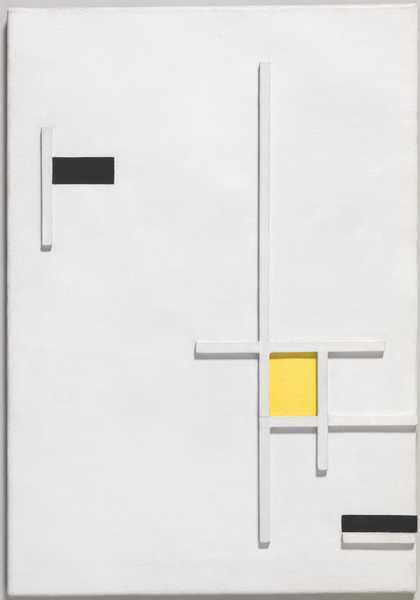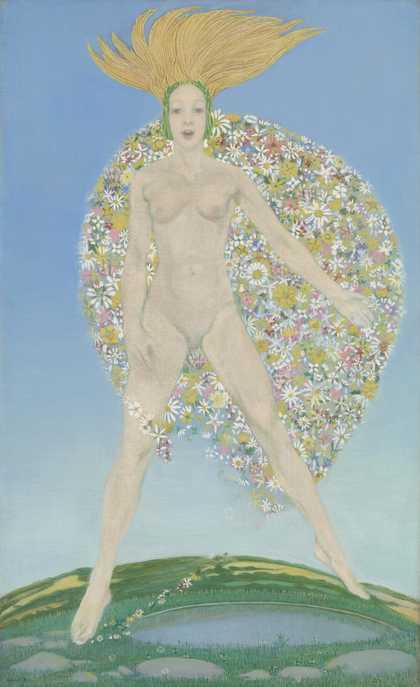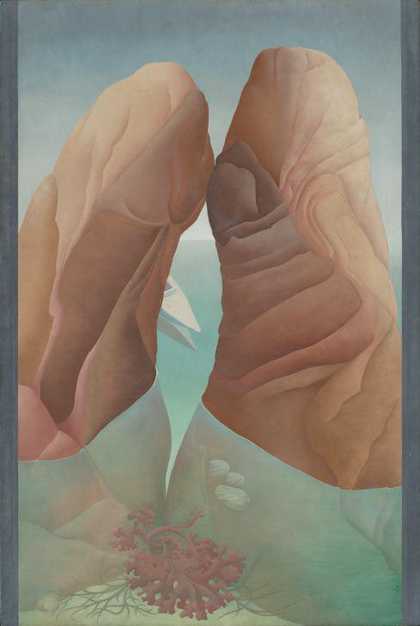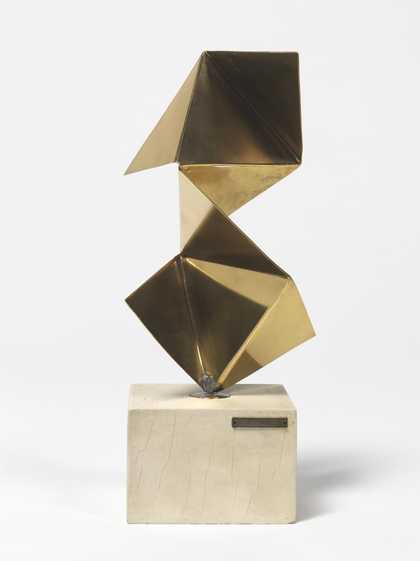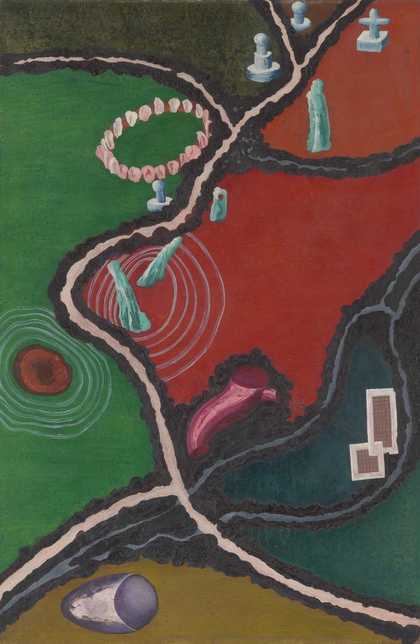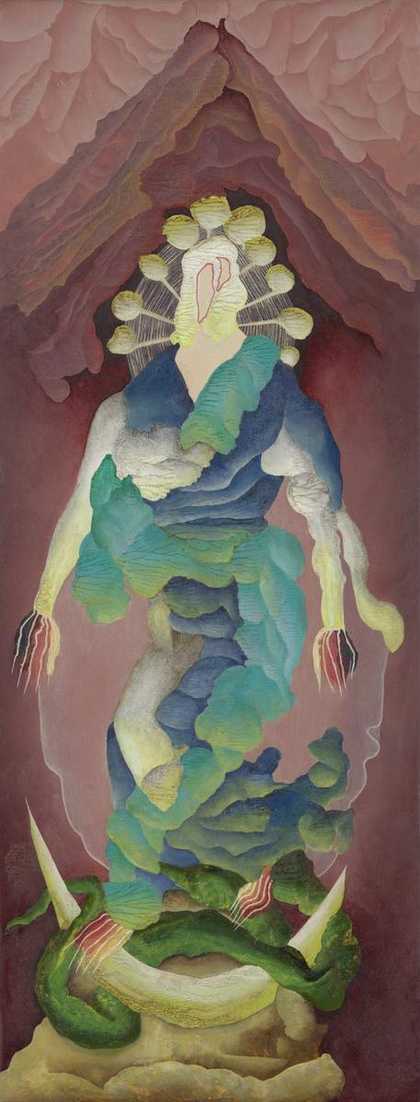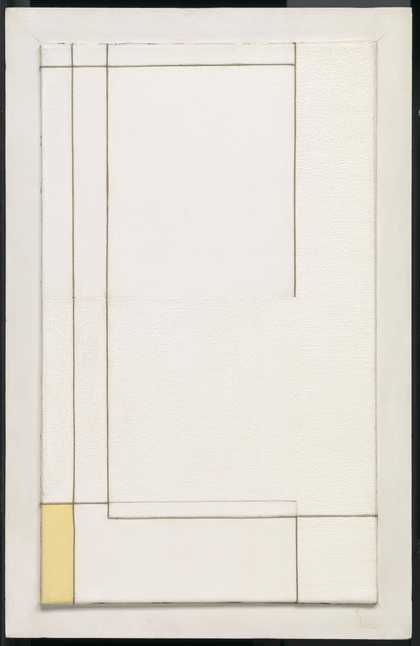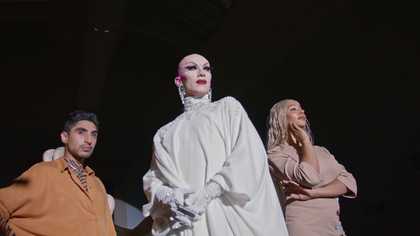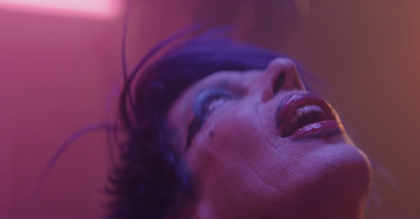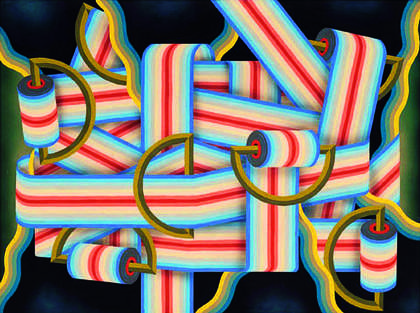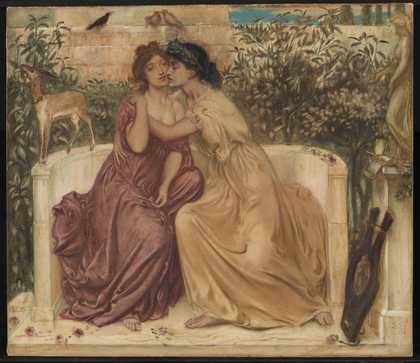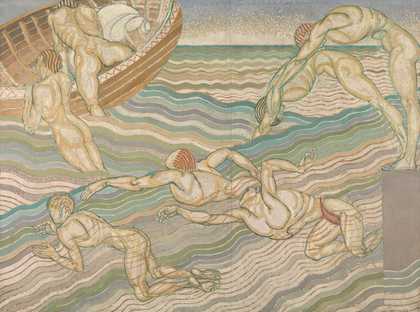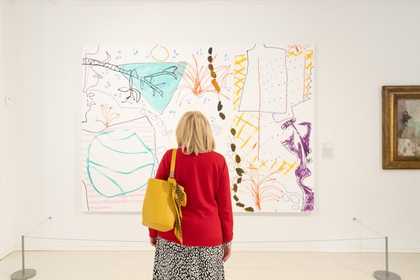InŌĆ»1949,ŌĆ»British artistŌĆ»IthellŌĆ»Colquhoun arrivedŌĆ»inŌĆ»Lamorna.
A small village on theŌĆ»edge of England,ŌĆ»knownŌĆ»forŌĆ»fishing, granite quarries, and as a magnet for artists.
Drawn by the cliffs, coves, andŌĆ»CelticŌĆ»standing stonesŌĆ»of West Cornwall, she soonŌĆ»discoveredŌĆ»the area'sŌĆ»lesserŌĆ»knownŌĆ»charms.
Colquhoun wrote:
Miss Moss andŌĆ»MmeŌĆ»Nyhoff lived together. Miss Moss had long ago had a relationship with Miss Palmer, who lived withŌĆ»MrsŌĆ»Dodd. Miss P had also had a relationship with Miss Gluck.ŌĆ»MmeŌĆ»Nyhoff went to Holland; Miss Moss had an affair with a mutual friend of theirs who lived in a caravan atŌĆ»TrecastleŌĆ»... [they] wanted this to be permanent but Moss turned her down. Moss suggested living withŌĆ»JanetŌĆ»but Janet turned her down.ŌĆ»MmeŌĆ»Nyhoff came back.
ColquhounŌĆÖs chronicle of queer relationships seems to be written with the voice of an outsider looking in.
Yet she once wrote aboutŌĆ»herŌĆ»love for aŌĆ»womanŌĆ»carryingŌĆ»ŌĆ»her, in swirling torrents, towardsŌĆ»ŌĆśthe lesbian shoreŌĆÖ.
Was it these same torrents that brought her to West Cornwall?ŌĆ» And into an avant-garde,ŌĆ»queer networkŌĆ»thrivingŌĆ»onŌĆ»these wildŌĆ»shores?
This is the story of Lamorna Cove, the heart of queer Cornwall, and three artists who lived and loved there.
British painter and sculptor Marlow MossŌĆ»came toŌĆ»LamornaŌĆ»inŌĆ»1941 with their partner, writer Netty Nijhoff.
As a Jewish and queer person in the early years of the Second World War,ŌĆ»Moss fled toŌĆ»Cornwall from France afterŌĆ»overŌĆ»a decadeŌĆ»workingŌĆ»in continental Europe.
They livedŌĆ»on and off in Lamorna until their death in 1958, when MossŌĆÖs ashes were scattered in the cove.
MossŌĆÖs work is abstract, bold, difficult, totally modern.
Unfortunately, art historyŌĆ»tends toŌĆ»placeŌĆ»Moss in the shadow of Piet Mondrian,ŌĆ»even thoughŌĆ»MossŌĆ»actually influencedŌĆ»hisŌĆ»workŌĆ»onŌĆ»at leastŌĆ»one occasion.
He was shocked by the wayŌĆ»MossŌĆ»introduced double lines to their abstract canvases. Moss told Mondrian that a single line grid was ŌĆ£a conclusion and a restrictionŌĆØ.
"I am no painter, I don't see form, I only see space, movement and light."
ThisŌĆ»sums up MossŌĆÖs approach to life.
Their arrival in Lamorna introducedŌĆ»the locals to a bold new look - on and off the canvas.
Moss abandoned a feminine birth name aroundŌĆ»1920ŌĆ»and adopted the gender-neutral ŌĆśMarlowŌĆÖ.
From their thirties until their death, Marlow presented in masculine ŌĆō and rather dramatic - attire.
Their sophisticated tailoring, riding crops and a short back and sides challenged gender norms.
"I destroyed my old personality and created a new one".
This transformation was totally queer, and totally modernist.
And it was their (uncompromising,) authentic approach that made MossŌĆÖs life in LamornaŌĆ” bittersweet.
"I am very much alone in my ideas here. I have seen Ben Nicholson just once, things arenŌĆÖt going well between us, I donŌĆÖt even know why, so I never see him".
For reasons we can only guess, MossŌĆÖsŌĆ»invitations to tea andŌĆ»overtures of friendshipŌĆ»toŌĆ»artists Ben Nicholson and Barbara Hepworth in the nearby modernist haven of St IvesŌĆ»went largely unanswered.
Moss wasŌĆ»a generousŌĆ»neighbour, who would give all the village children sweets at Christmas.
ButŌĆ»the kids also spied onŌĆ»Moss while they were swimming, tryingŌĆ»to work out their sex. Their butch presentation was radically brave, at the time, and even today. Telling MossŌĆÖs story asks us to consider our concepts of gender, and how we perceive queer icons of the past.
WhileŌĆ»Moss mayŌĆ»wellŌĆ»have been happy being described with the binary pronouns of their time,ŌĆ»we can never be sure. Neutral pronouns are often used when referring to them -ŌĆ»an option which honours allŌĆ»possibilities,ŌĆ»andŌĆ»draws no conclusions.
After all, it was Moss who said thatŌĆ» "Art isŌĆ»-ŌĆ»as lifeŌĆ»-ŌĆ»forever in the state of Becoming".
A sentiment no doubt shared by their neighbour and fellow queer trailblazer - the artist exclusively known as Gluck.
"I am flourishing in a new garb. Intensely exciting. Everybody likes itŌĆ” I hope you will like it because I intend to wear that sort of thing always."
Gluck ŌĆō a one word name, "with no suffixes, no prefixes, noŌĆ»quotes".
InŌĆ»1916,ŌĆ»Gluck travelled to Lamorna with their friend, fellow artist and possibly their lover,ŌĆ»Craig ŌĆō another self-chosen, single word nameŌĆ»free from the constraints of gender.
GluckŌĆÖs mother, none-too-happy with these developments, called CraigŌĆ»"a pernicious influence",ŌĆ»ŌĆ»andŌĆ»labelled the artistŌĆÖsŌĆ»infatuationŌĆ»with each other asŌĆ»"a kink in the brain".
As recent graduates eager for new experience, Gluck and CraigŌĆÖsŌĆ»arrival in LamornaŌĆÖs artist colony must have beenŌĆ»a life-changingŌĆ»adventureŌĆ»ŌĆōŌĆ»andŌĆ»world away from theŌĆ»(uptight) high-society dinner parties of their youth.
The iconic painting Medallion, GluckŌĆÖsŌĆ»self-portraitŌĆ»with NestaŌĆ»Obermer,ŌĆ»isŌĆ»a rare example of the artist withŌĆ»a female lover.ŌĆ»Traditional in style,ŌĆ»radical in its representation.ŌĆ»ŌĆ»A striking yet intimateŌĆ»portraitŌĆ»ofŌĆ»a couple,ŌĆ»ofŌĆ»queer figures in love.
If art and life are intertwined in MossŌĆÖs work, art and love are constant companions in GluckŌĆÖs.
Upper-class, wealthy, and business-minded, Gluck inventedŌĆ»and patentedŌĆ»their ownŌĆ»bespokeŌĆ»frame,ŌĆ»wonŌĆ»a decade-long legal battle that reformed the accepted standards for oil paints, andŌĆ»challenged anotherŌĆ»artist's use of the name ŌĆśGl├╝ckŌĆÖ,ŌĆ»with anŌĆ»umlaut.
Gluck said thatŌĆ»their paintings of the Cornish countryside were, "The first that truthfully showed the immediate impression one gets there ŌĆō that of very little land and great expanses of sky".
FloraŌĆÖs CloakŌĆ»is an empowering depiction of a womanŌĆ»set in this great expanse...ŌĆ»the Cornish landscape transformed intoŌĆ»a magical and mythical space.
TheŌĆ»sea, cliffs, coves and sky of LamornaŌĆ»wereŌĆ»a mysterious,ŌĆ»psychic space, as well as aŌĆ»physical landscape,ŌĆ»for GluckŌĆ»ŌĆō but also forŌĆ»our final subject,ŌĆ»Ithell Colquhoun...
"Here, to exist is enough; one scarcely needs diversion, for the slightest happenings seem full of a crazy zest"
By the time Ithell Colquhoun moved toŌĆ»LamornaŌĆ»she had already lived in Paris, travelled through Greece, Tenerife, and Corsica, and had split from both her husbandŌĆ»andŌĆ»from the British Surrealists.
She was heavily influenced by their style throughout her career,ŌĆ»butŌĆ»theŌĆ»strict rules of theŌĆ»surrealist movementŌĆ»jarred with ColquhounŌĆÖs interest in the Occult, and she was pushed out because of it.
Colquhoun lived a rather solitary life in Lamorna.
SheŌĆ»rented a ramshackle hut with no modern facilities which she named Vow Cave.
ŌĆ»ThisŌĆ»became her home and studio; andŌĆ»LamornaŌĆ»Valley, her inspiration ŌĆō
"Valley of streams and moon-leaves, wet scents and all that cries with the owlŌĆÖs voice ŌĆ” Influences essences, presences, whatever is here ŌĆ” I share this place with you, ... for all you give me I offer thanks."
ColquhounŌĆ»was fascinated by the Occult, Celtic mysticism and the mythical ŌĆśAndrogyneŌĆÖ ŌĆō a two-faced creature who existed at the beginning of creation, combining both male and female traits.
This mystical view ofŌĆ»nature is laid bare inŌĆ»the painting Scylla.ŌĆ»Figurative, butŌĆ»oddly dream-like, beautifulŌĆ»andŌĆ»androgynous,ŌĆ»the viewer becomes the legendaryŌĆ»Scylla herself,ŌĆ»gazing through a pair ofŌĆ»thighsŌĆ»-ŌĆ»or perhaps a pair ofŌĆ»narrow,ŌĆ»phallicŌĆ»cliffsŌĆ»- at an oncoming ship.
Though she neverŌĆ»publiclyŌĆ»identified as lesbian, bi- or pan-sexual, Colquhoun wrote about sapphic desire for theŌĆ»GreekŌĆ»woman AndromaqueŌĆ»KazouŌĆ»:
"I did not try toŌĆ»analyseŌĆ»the stirrings within me, I could not reflect upon them while thus borne along. It was not until later and in calmer intervals, that IŌĆ»recognisedŌĆ»this torrentŌĆ»that swirled me onwardsŌĆ»ŌĆ”ŌĆ»I was being carried, indeed, to the Lesbian Shore".
"If ever a country was 'pixielatedŌĆ”'"ŌĆ» said Gluck "ŌĆ”itŌĆÖs Cornwall."
LamornaŌĆÖs queer trailblazers heldŌĆ»a love forŌĆ»CornwallŌĆ»that was deep and enduringŌĆ»- if, perhaps,ŌĆ»romanticised.
The freedom to live authentically in aŌĆ»ruralŌĆ»village, while travelling often to London andŌĆ»Paris, was made possible by their financial resources.
As upper-middle class artists, Gluck,ŌĆ»Moss and ColquhounŌĆ»were afforded a social mobility rarely enjoyed byŌĆ»the local population - and a world away from the lives of their queer working-class neighbours.
ItŌĆÖs these queer Cornish voices ŌĆ»ŌĆōŌĆ»some named in the writings of Ithell Colquhoun -ŌĆ»who are rarelyŌĆ»documented. Who was Miss Palmer? Who wasŌĆ»Janet?
Still,ŌĆ»this drive to seek connection, community and re-invention outside of your birthplace and class structure isŌĆ»a queer rite of passage. Moss, Gluck and Colquhoun each found an opportunity to live truthfullyŌĆ»and with greater privacyŌĆ»inŌĆ»Lamorna.
ThisŌĆ»small fishing village, not far from LandŌĆÖs End,ŌĆ»was their shared passion, inspiration and refuge.
Lamorna is a small village on the Cornish coast, in the far southwest of Britain. The expansive skies and landscapes of the area have long been a draw for artists, most famously painters associated with the Newlyn school such as Laura Knight, Alfred Munnings and Lamorna Birch.
Less well known are the ground-breaking queer artists who set down roots in the village: Marlow Moss, Gluck and Ithell Colquhoun.
In this film, we tell their story, and the story of the Cornwall where they lived and loved: a place of international modernism, Celtic spiritualism and the queer avant-garde.
A Note on Language
Telling the stories of these three artists asks us to consider our concepts of gender and sexuality, and how we perceive and represent queer figures of the past. The word ŌĆśqueerŌĆÖ itself has a mixed history, used both as a term of abuse and as a term by LGBTQIA+ people to refer to themselves. In recent times, it has become reclaimed as a fluid term for people of different sexualities and gender identities. In this film, we use ŌĆśqueerŌĆÖ in this broad and inclusive sense, rather than making specific assumptions about how these artists would choose to identify.

